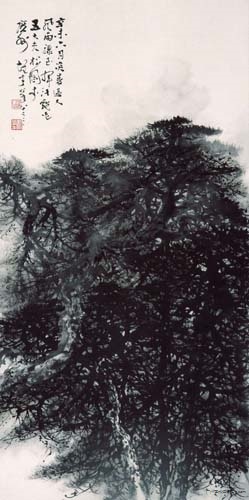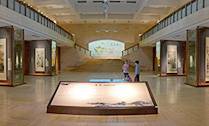Forever Young: Paintings by Li Xiongcai in Collection of Guangzhou Museum of Art
Release time:19-04-11
Born in Zhaoqing of Guangdong Province, Li Xiongcai (1913—2001) was an outstanding Chinese painter and art educator, who was also a representative of masters of the Lingnan School of Painting.
In 1923, he was enrolled by the Zhaoqing Middle School, and studied with Chen Jian, a disciple of the noted Lingnan flower-and-bird painter Ju Lian. In 1930, he entered the Chunshui Art Academy and learned painting from Gao Jianfu, the founder of Lingnan School of Painting. Then he entered the Guangzhou Liefeng Art School and studied sketches in 1931. In 1932, he went abroad to Japan and studied at the Japanese Painting Department of the Tokyo School of Fine Arts. After graduated in 1934, he returned to China and taught at the Guangzhou Municipal Fine Arts School. In 1953, he served as an associate professor at Wuhan Zhongnan Art College. Since 1958, he has served as professor of the Guangzhou Academy of Fine Arts, dean of the Chinese Painting Department, and vice president of the Academy. He was a member of the China Artists Association and the vice chairman of the Guangdong Artists Association. In 2001, he won the first China Fine Arts Gold Award.
Li Xiongcai was specialized in landscape as well as flower-and-bird. His landscape paintings were influenced by the styles of Gao Jianfu, the royal painting academy of the Song Dynasty and modern Japanese paintings. Afterwards, he absorbed essence from both ancient and modern genres and established his own approach with a unique technique in using dry ink. The works of his later years became more sophisticated and unrestrained.
Li Xiongcai had a passion for pine trees. As early as in Japan, he had painted a lot of pine trees. In his later works, the pine tree had always been his subject by a large proportion, and “his paintings are not done without pine trees”. Throughout his life, pine had become an important part of his artistic creation. Therefore, some people call him “the poetic artist who painted pine trees with a vigorous approach”. His works are recognized by people as “landscapes and pine trees with a signature style of his own”. His paintings of pine trees were fierce with a mature and powerful approach.
To d
In 1923, he was enrolled by the Zhaoqing Middle School, and studied with Chen Jian, a disciple of the noted Lingnan flower-and-bird painter Ju Lian. In 1930, he entered the Chunshui Art Academy and learned painting from Gao Jianfu, the founder of Lingnan School of Painting. Then he entered the Guangzhou Liefeng Art School and studied sketches in 1931. In 1932, he went abroad to Japan and studied at the Japanese Painting Department of the Tokyo School of Fine Arts. After graduated in 1934, he returned to China and taught at the Guangzhou Municipal Fine Arts School. In 1953, he served as an associate professor at Wuhan Zhongnan Art College. Since 1958, he has served as professor of the Guangzhou Academy of Fine Arts, dean of the Chinese Painting Department, and vice president of the Academy. He was a member of the China Artists Association and the vice chairman of the Guangdong Artists Association. In 2001, he won the first China Fine Arts Gold Award.
Li Xiongcai was specialized in landscape as well as flower-and-bird. His landscape paintings were influenced by the styles of Gao Jianfu, the royal painting academy of the Song Dynasty and modern Japanese paintings. Afterwards, he absorbed essence from both ancient and modern genres and established his own approach with a unique technique in using dry ink. The works of his later years became more sophisticated and unrestrained.
Li Xiongcai had a passion for pine trees. As early as in Japan, he had painted a lot of pine trees. In his later works, the pine tree had always been his subject by a large proportion, and “his paintings are not done without pine trees”. Throughout his life, pine had become an important part of his artistic creation. Therefore, some people call him “the poetic artist who painted pine trees with a vigorous approach”. His works are recognized by people as “landscapes and pine trees with a signature style of his own”. His paintings of pine trees were fierce with a mature and powerful approach.
To d



 Party's mass line
Party's mass line Activity Booking
Activity Booking Hall of Fame
Hall of Fame Donation
Donation Construction
Construction